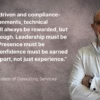
There are more virtual teams today than ever before. The definition of what a virtual worker and/or team continues to change and evolve. There are a variety of factors that have contributed to this increase, and change, including globalization, shifts in technology, variations in competition, and increased responsibilities. Research from Global Workforce Analytics and the US Census Bureau shows how significant this trend is:
- 50% of the US workforce holds a job that is compatible with at least partial telework and approximately 20-25% of the workforce teleworks at some frequency.
- 80% to 90% of the US workforce says they would like to telework at least part time. Two to three days a week seems to be the sweet spot that allows for a balance of concentrative work (at home) and collaborative work (at the office).
- Fortune 1000 companies around the globe are entirely revamping their space around the fact that employees are already mobile. Studies repeatedly show they are not at their desk 50-60% of the time.
Whether you are a managing a global team with members in different countries, a team whose interactions are impacted by travel or preferred work schedule, or a team who work in different offices/locations, how you manage the work and lead your people needs to look different than it has before.
Below are three important points to keep in mind.
1. You will need to put more of an emphasis on managing.
While co-located teams often benefit most from a leader who acts as a facilitator, virtual teams need a manager who provide clearly defined direction and removes all ambiguity from the process. When a team works together in the same office, you can have loose job descriptions, possibly even with two people sharing elements of the same role. In virtual teams that just doesn’t work. Team leaders have to formalize roles and responsibilities–starting with their own. They also need a strong process by which you clarify and track commitments.
2. You must build relationships differently.
Relationships take on a whole new meaning in virtual teams. When you meet your workmates by the water cooler or photocopier every day, you know instinctively who you can and cannot trust, and relationships tend to form more readily. In a virtual team, you need to create situations where interactions occur, “meeting regularly”. This should be done both online ‘through IT technology such as video conferencing, social media or Skype” and face-to-face, at least once or twice a year. Even if companies are cutting costs, it’s a cost well spent on building relationships.
3. You must communicate differently.
The utmost key to virtual team leading is, without doubt, communication. Communication on virtual teams is often less frequent, and always is less rich than face-to-face interaction. The only way to avoid the pitfalls is to be extremely clear and disciplined about how the team will communicate. Create a charter that establishes norms of behavior when participating in virtual meetings, such as limiting background noise and side conversations, talking clearly and at a reasonable pace, listening attentively and not dominating the conversation, and so on. The charter also should include guidelines on which communication modes to use in which circumstances, for example when to reply via email versus picking up the phone versus taking the time to create and share a document.
Virtual teams present a tremendous opportunity to expand your skill set as a manager and leader. You need the skills we mention above, as well as the more traditional management and leadership behaviors. The key is leveraging each appropriately.
How do you manage virtual teams and employees?
About the Author: Cheryl Jacobs
About MCG Partners
MCG Partners a woman-owned, Greater Boston-based consultancy specializing in executive coaching, leadership development, talent management, and organizational development solutions. We help businesses optimize success through the entire management life-cycle. MCG Partners is also a Predictive Index® (PI®) certified partner.
To learn more about MCG Partners’ services or The Predictive Index®, contact John Griffith at john.griffith@mcgpartners.com or visit mcgpartners.com.








